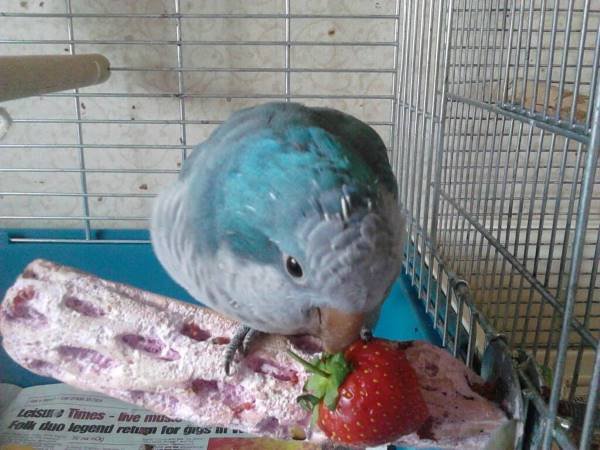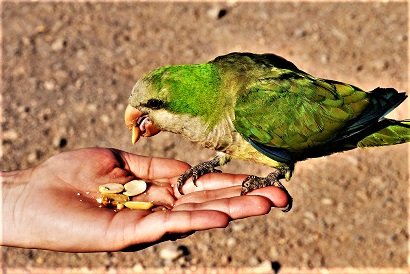Pets are great companions and if those pets are cheerful vibrant colored birds, everyone adores them. The most famous bird pets happen to be parrots. If it hadn’t been for their bright multi-colored feathers, there wouldn’t be anything worth the hard work for the owner in his tiring day. Canaries, Macaws, Budgies, Sun Conures, Finches, Quakers, name them and all you can think is a small parrot as cheerful as they are beautiful. And the credit goes to the feathers grown all over their body. But do you know, they aren’t just for visual admiration. Feathers are the indicators of parrot’s health and behavior. And Quakers are no exception.
What feathers tell about your parrot?
Quaker parrot feathers are majorly green in color throughout their bodies. Though Quaker parrot flight feathers have a blue tinge. With numerous color mutations, the color of their feathers vary. But in any case, the feathers of a Quaker should be lustrous and bright. The healthy-looking feathers mean that the bird is preening them religiously.

What do parrots use for preening their feathers? To preen themselves, parrots take the oil secreted from their preening gland aka uropygial gland and spread it over their feathers. The oil conditions the feathers which help in aligning them along with keeping them moisturized. Removal of all the dust and debris are just a bonus in the process. And all this comes naturally to Quakers. A bright, shiny, and healthy-looking feathers mean a healthy and happy parrot.
But if the bird isn’t doing it properly, you’ll notice a Quaker parrot poor feather quality. His feathers will be dull, dry and brittle. And the parrot will start losing feathers rather sooner than later.
Why your Quaker parrot is losing feathers?
A Quaker parrot losing feathers is completely normal more often than not. Though it is not necessary as sometimes a Quaker parrot feather loss could be unnatural too. A Quaker might start losing feathers for varying reasons:
Quaker parrot Molting
Anyone who has Quaker as a pet would have either seen his parrot shedding his feathers or will soon witness it. The process is natural to all the Quakers and is known as molting. A Quaker parrot molting would start shedding his feathers symmetrically. Say, if one notices his Quaker parrot losing feathers around the neck, it will be in symmetry on the left and right side of the neck. Any unequally distributed act of Quaker parrot feather shedding would not account for molting at all.
A Quaker parrot molting feathers can usually be noticed after breeding season. And the major reason he experiences it is for replacing old feathers that have been worn out and are useless for him. Quakers might experience a molt once or twice a year. Sometimes, one might notice his Quaker parrot losing feathers on head almost instantly and completely. This happens in some of the juveniles before their first molt. Though this is uncommon but is completely natural.
Molting always starts with the shedding of a few feathers here and there. Never will a Quaker completely go bald in the process. If it happens, there is something serious going on with the bird and he needs immediate medical attention. After shedding feathers at places and Quaker parrot new feathers will start growing in those empty follicles even if there still are old feathers at some places. And the new feathers are called pin feathers.
What are pin feathers? When new feathers of Quaker is growing, they are pointed and sharp just like a pin, hence, the name. A Quaker parrot pin feathers are thin tube-like structures that appear pink at the bottom due to being connected to blood supply and are little white at the top. They stay connected to the blood vessels to receive oxygen and nutrients until they grow completely inside a hard sheath.
Sometimes the Quaker can accidentally break his pin feathers. Most of the times, he’ll take this out himself, but if he doesn’t, the owner must remove the broken pin feather to prevent excessive blood loss. When a particular feather grows completely, it gets cut from the live blood vessel. The Quaker will pull the hard sheath off it, thereby, exposing his new shiny feathers.
During molting, the Quaker owners witness what is known as Quaker parrot molting behavior. When new feathers are growing, they are pointed and are a source of discomfort for the bird. This makes them grumpy and they keep in itching. A Quaker might like to sleep away the pain and itch if he feels a lot of pain and itch on some days.
To know how one can help his bird, the following video might be of help:
Quaker parrot Plucking
A Quaker parrot picking feathers is quite a normal site and he does this while his pin feather gets broken before attaining complete growth. Since such a feather is still connected to living blood vessels, it hurts like a wound. To lessen his pain, the Quaker picks it out. But it is not a regular phenomenon and hence, happens when the situation arises.
Why my Quaker parrot is plucking feathers?
If the above question has crossed one’s mind seeing his parrot plucking too much, then his Quaker parrot needs attention. Too much feather plucking is the sign of a bored and lonely bird. Another reason could be a feeling of irritation on his skin due to some chemical in the surrounding environment like cleaners, etc. Low air humidity, bacterial or fungal infection, liver disease, allergies, heavy metal poisoning, and cancer are some of the more serious plucking reasons.
And if those feathers are still connected to the live blood vessels, the repetitive plucking might damage the follicles resulting in permanent damage. No new feather will grow from that follicle again. Therefore, immediate medical attention becomes imperative to diagnose the real cause and its solution thereof.
Malnutrition
Malnutrition gives rise to many Quaker parrot feather problems and if not dealt early on, it might get fatal for the bird. Quaker’s feathers are majorly made up of protein and just like human hairs, they need protein-rich diet from falling off. But protein is not the only requirement for Quaker’s beautiful feathers. A balanced diet of all vitamins and minerals is a must for keeping Quaker feathers full and lustrous. For eg., Vitamin A deficiency can result in bald patches. Feeding a premium pellet mix along with fresh fruits and vegetables would keep Quaker’s feathers from falling off untimely.
Grooming
Grooming is a must for all the birds and this holds for Quakers too. And the major part of grooming is formed by preening. Realigning their feathers by using their body oils is a part of their daily routine. A Quaker parrot ruffled feathers are a sign of his shaking off all the dust and debris during the process. But if one sees more than a few lost feathers after the bird has shook them off, it is a sign of excessive preening. When new to the process, Quakers might not figure out the difference between a soft preen and a hard pluck. And if it becomes a regular sight after his daily preening session, the bird needs to be trained to prevent from going bald.
Do Quaker parrot’s tail feathers grow back?
To know whether Quaker parrot tail feathers will grow back or not, one needs to determine the damage caused to the follicle from which the feathers grow. In general, Quaker parrot feather plucking might cause bald patches if the behavior is not controlled in the initial stages. These bald patches can fill up over time. It can take several weeks to several months for Quaker parrot’s tail feathers to grow back.
When the feather follicle of the Quaker parrot suffers from severe damage, the tail feathers might not grow back. This is because the root from which the feathers originate has been damaged permanently resulting in no regrowing at all.
This makes it all the more important for the owners to take care of their pet Quaker’s plucking behavior and address the problem as and when it arises.
How to regrow my Quaker parrot’s feathers?
Quaker parrot’s diet plays a major role in regrowing his feathers fast. A lot of fruits and vegetables along with a high-quality feather-growth supplement will make the process easier. Sunlight is the other main factor that is responsible for the healthy growth of the bird’s feathers. In winters, consider purchasing full-spectrum light to mimic the effects of natural sunlight.
Conclusion
Feathers are a guide to parrot’s health. One can know his parrot well by examining his feathers closely. Say, a dull-colored feathers mean lack of Vitamin D and would need one to take his Quaker out in a mild sunlight; discolored feathers mean a Quaker with poor nutrition who needs medical attention as it may harm the liver; discolored structured lines or bars in a set pattern mean environmental or dietary issues during Quaker’s first molt and to reverse the effect, a proper care is the only solution; dark or oily feathers hints at excess fat in his diet and could mean a probable liver disease. All one needs to do is understand what his bird’s feathers are hinting at and act as soon as possible to keep his bird healthy and hearty.




